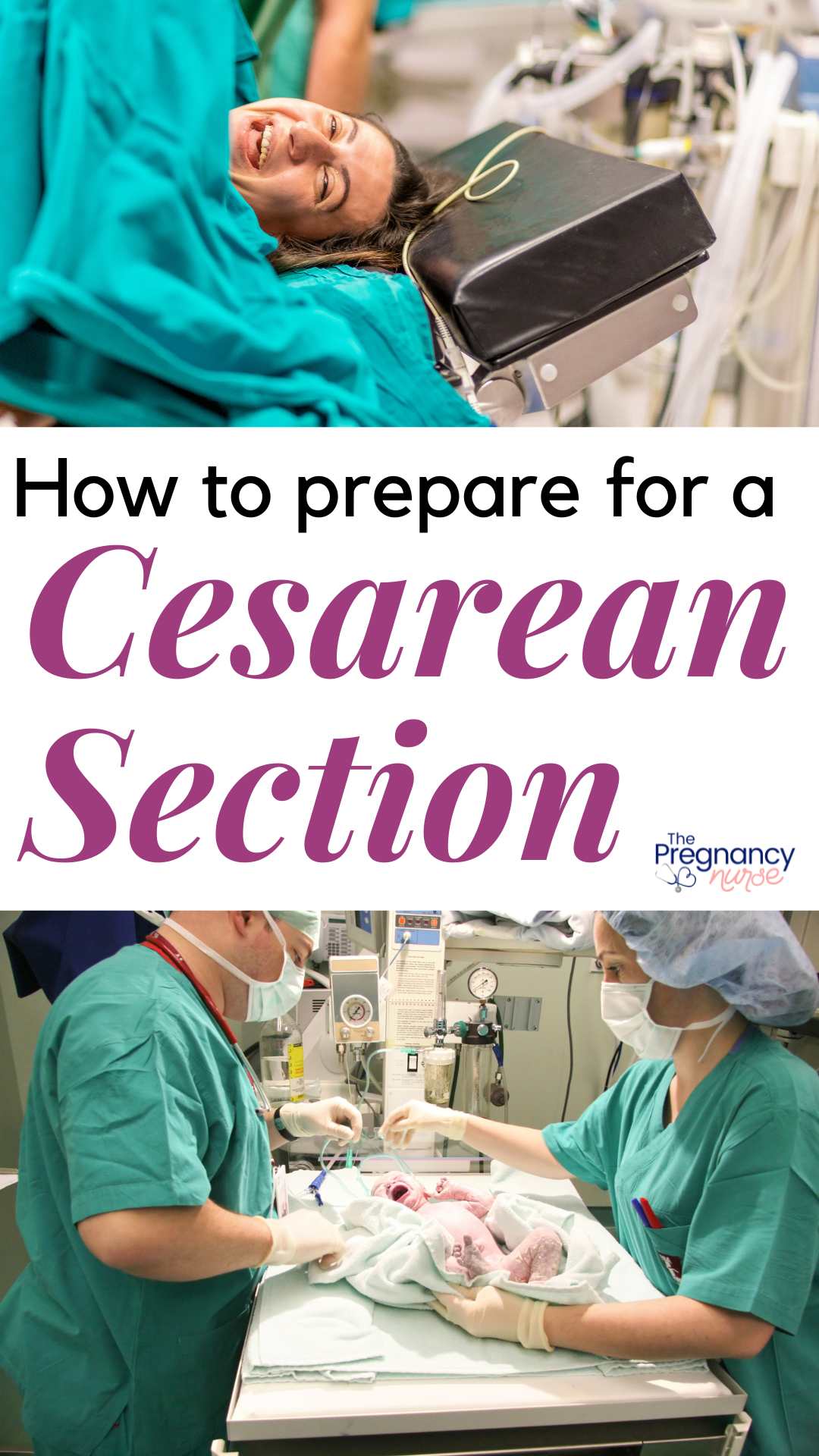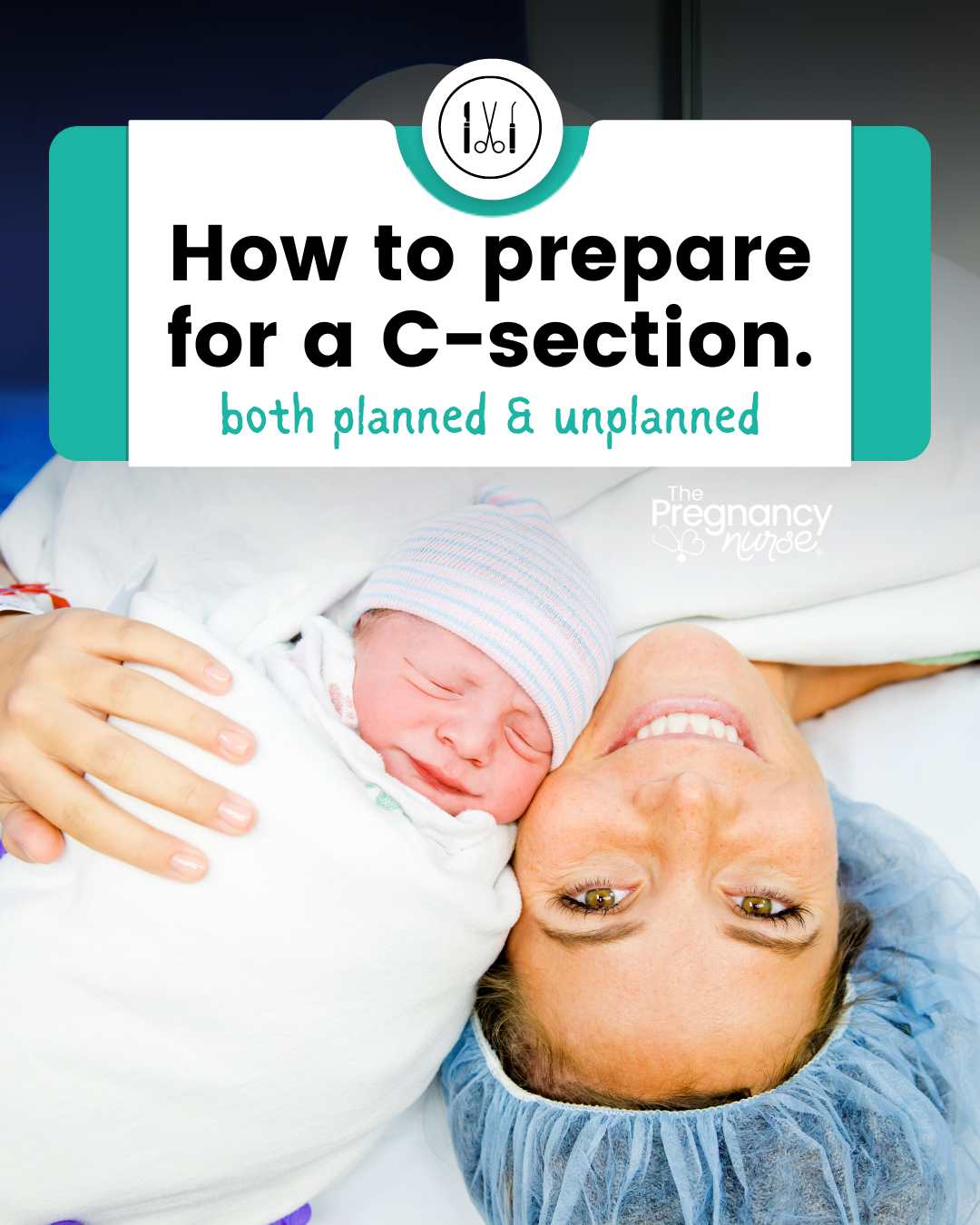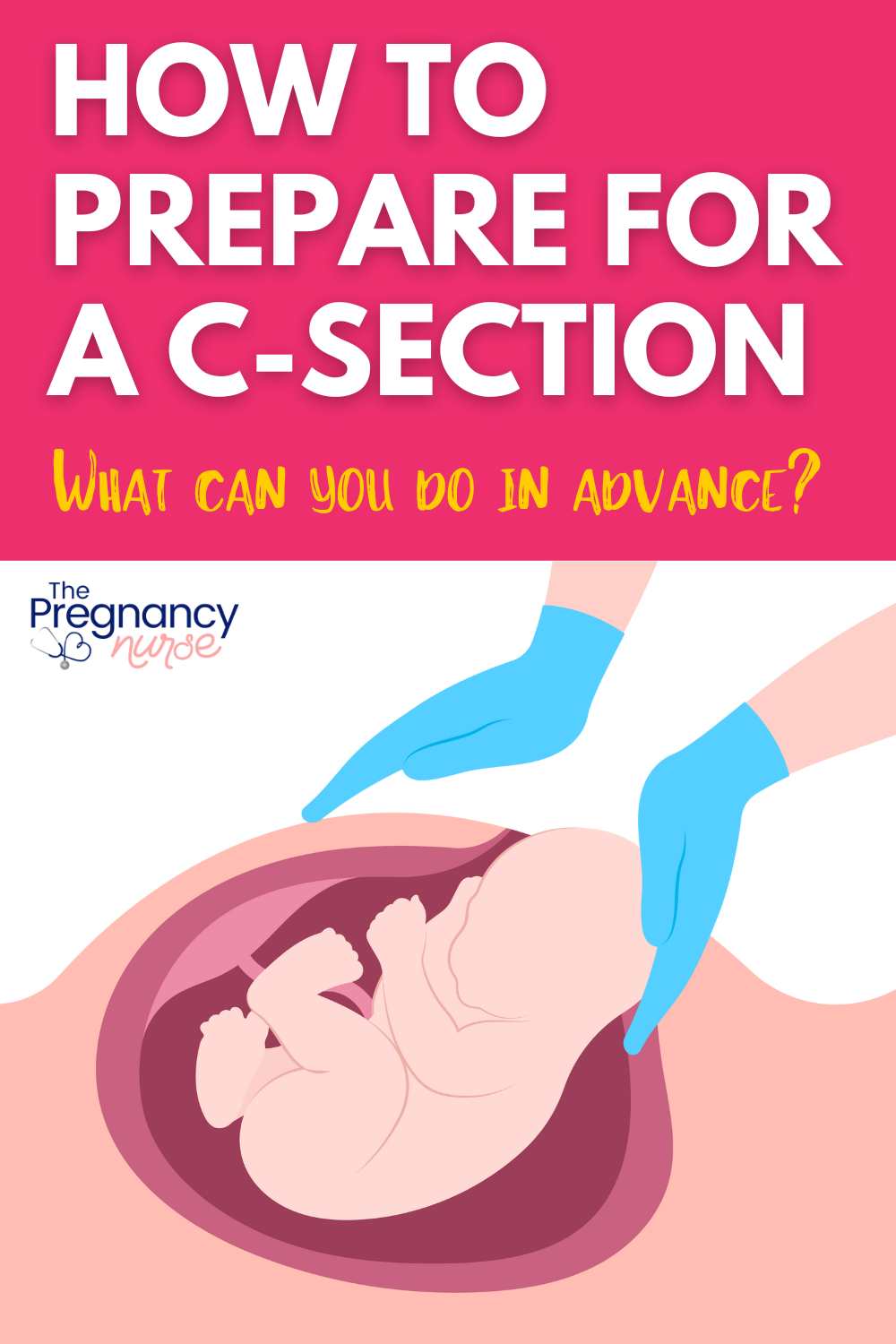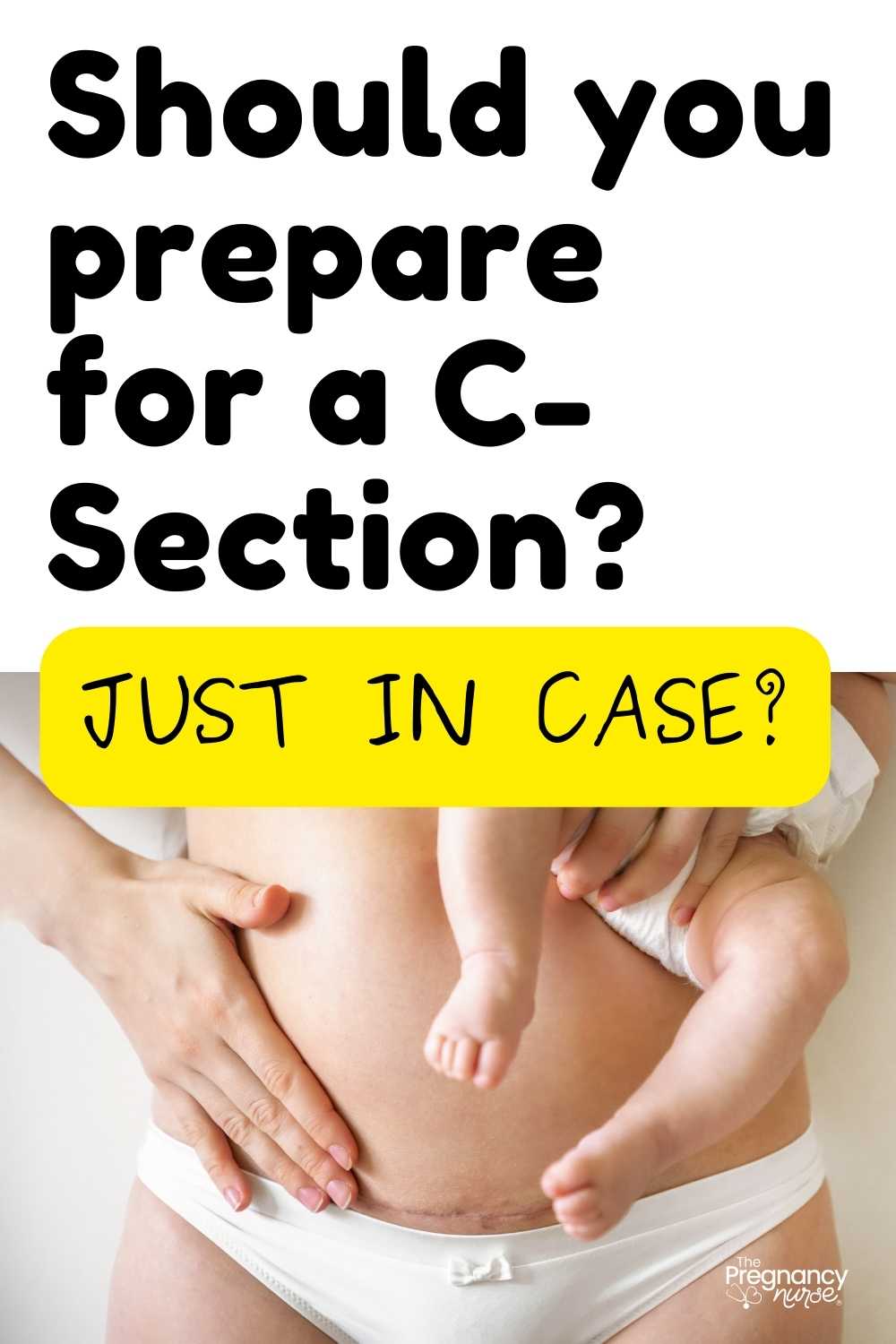📣 YOU are clearly getting prepared for pregnancy, birth & beyond — but do you wish your partner was more involved (looking for a teammate rather than just a cheerleader)? Couples love THIS! 💛🧡💚
So, you’re pregnant and either aware there’s a decent-sized chance you could have a c-section, OR you have a scheduled c-section (or are planning to) and you’re wondering how to best prepare for the surgery? I’ve got the best tips for you in both instances — as a labor nurse for 20 years I’ve helped a LOT of patients, and I know I can help you too!
Quick reminder that about 1 in 3 people ends-up having a c-section in the united states. While it’s REALLY important to talk through the reasons with your provider before making the choice it’s best for you (we talk a LOT about that in here) in this article we’re just going to talk about preparing for the actual procedure. I have a few tips I can send you via email as well.
Mentally Preparing for a C-section
Most people that come into labor and delivery have not had surgery, let alone major abdominal surgery like a C-section. I think it’s really important for you mentally prepare that it’s an option. I 100% recommend taking The Online Prenatal Class for Couples where we talk about both vaginal and cesarean deliveries. But we’ll also go through the admission process (same for both) and tips for managing your life postpartum (including great postpartum tips).
I think being aware of what’s going to happen can be SO helpful. For instance did you know?:
- It’s likely going to be cold in the room, but you can ask them for things to help make you warmer (it’s to help reduce the risk of an infection)
- There will be a LOT of counting going on
- Your partner will probably be in the surgery in a special spot next to you (important that they are prepared too)
- You will have a catheter (that will removed a bit after the surgery once you can get up and pee)
- You will deliver in an operating room, not a delivery room (this makes sense but a lot of people are surprised by it).
- You will likely go to a recovery room after delivery where there may be special rules due to you just having had surgery and keep you safe (including how many people can come see you).
I could go on and on about who’s in the room, and how long it takes — but knowing those things is SO helpful. That’s why this is helpful.
If you’re JUST having a c-section and ONLY want to know about the c-section procedure (and a few tips in particular for postpartum as a c-section patient) you can also check out C-sections made easy. It’s JUST C-section info — you might prefer that…. but I’d still recommend the full class as there’s lots more info about everything in there.
I think it’s really clear to understand that most people bring some fear into the surgery room — and that’s totally normal and OK. Just knowing what’s going to occur in there will help a LOT!
C-Section Birth Plan
The good news is that you can still make a birth plan, and a lot of it is very similar to a vaginal delivery. Of course, I prefer to call these childbirth preferences — but if you’d like to do skin-to-skin as soon as possible your team can still try to make this happen. Grab my free birth plan printable (and helpful video) here:
Now, beyond the actual procedure — there are a few other things to prepare for:
What is the best last meal to eat before a C-Section?
My vote is something you love, but not too heavy (or don’t eat a ton). You’re likely to be a bit nervous, and possibly not sleep very well. Most providers don’t want you to eat anything 8-12 hours prior to your surgery. For most people that means the last meal is the night before. You may be able to drink clear liquids after that — but check with your provider.
There’s no real reason to eat something special — but I think eat something that will make you happy. This is one of the last meals you’ll eat without a little person to tend to!
What happens if you eat before a C-section?
So, let’s pretend your provider said NOT to eat 8 hours before the surgery, but you do.
First off, it’s SO important to be honest when they ask you when you last ate. It is really important for anesthesia to know what’s in your stomach before the surgery for a variety of reasons.
The biggest reason is that if you were to throw-up we don’t want food going into your lungs.
They may end up postponing it if it is an issue.
That being said we do surgery on people all the time who have recently eaten, we just prefer not to (and it increases your risk).
Looking to get prepare for your birth? I have some easy options for you!
~~~~~~~~
– Worried you’re missing something? Grab my pregnancy planner so you don’t miss a thing!
– Thinking about an induction? Grab Inductions Made Easy to feel prepared in just 20 minutes!
– Wondering how to get that baby OUT? Grab Going Into Labor Made Easy so you know how to (and not to) do it!
– Postpartum got you anxious? Check out Postpartum Care Made Easy so you can stay SAFE even when all your attention is on that little on.
🚨 AND if ALL OF IT has got you on edge The Online Prenatal Class for Couples is perfect for you — You’ll feel so ready before you even know it!
~~~~~~~~
No matter WHERE you are at in your pregnancy journey, we have resources that can help!
Preoperative Preparation for a Cesarean Section
It seems like most people aren’t told to do anything. No, you don’t need to shave (we make sure that area is clear before the procedure, and we actually only need the very top part of pubic hair shaved to say out of the incision site).
Some people are given a special soap and told to shower with it prior to coming in.
But, that’s about it.
Pro Tip: Worried about how nervous you’ll be? You can always ask your provider for something to help you sleep before. See what they say!
How to prepare for C-section Recovery
It’s smart to think about how your body will be after the surgery. You’ll want to be very tender with your abdomen. I go into more tips in here, but here are a few you’ll want to watch for:
Plan on high-waisted, or no-waisted items. Your surgical scar will be right where your body naturally bends. It’s called a bikini line scar. So, you won’t want your underwear coming right in that area — so getting some high waisted panties, leggings, etc. People also LOVE to wear dresses. They sometimes look a bit nicer and put NO pressure in that area.
Your breastfeeding journey may be a little different. They say that sometimes your milk takes longer to come in if you have a c-section vs a vaginal delivery. It can be a good idea to take a breastfeeding class (this one includes one in the bundle) and have some good resources where you could get a consult if necessary.
You’ll still bleed — a lot of people are caught off-guard by this. The bleeding actually comes from where your placenta detaches (which happens in both a vaginal and a c-section birth). So, you’ll still need all the pads, etc. Grab my postpartum checklist here:
I think it’s important to know that you’ll do SO much better if you move — even if it hurts a LOT. Yes, you’ll be slow — but the more you move the better you’re going to feel. So, mentally preparing for being strong and doing things that will help you long term (even if they’re not fun right now).
I would also recommend knowing what things to watch for postpartum. You may be at a higher risk for things like blood clots, heart or blood pressure issues and there are true standards of when you should go straight to the ER if you’re seeing something or if it can wait for a phone call to your provider. I talk more about those in my free class Postpartum Care Made Easy.
How to prepare for a planned C-section
If you KNOW you’re going to have a c-section, you want to be sure to be prepared (this class is awesome for these people). Ask your provider if they have any information about how cesareans work at your hospital, or what to expect during your hospital stay (our hospital had a pamphlet for c-section moms to help them understand the process a bit more).
It can be tempting to think you JUST want to prepare for a c-section but knowing the admission process, plus more about postpartum is a big win. If it’s at all possible I recommend this full prenatal class instead of just the c-section targeted class).
Looking to get prepare for your birth? I have some easy options for you!
~~~~~~~~
– Worried you’re missing something? Grab my pregnancy planner so you don’t miss a thing!
– Thinking about an induction? Grab Inductions Made Easy to feel prepared in just 20 minutes!
– Wondering how to get that baby OUT? Grab Going Into Labor Made Easy so you know how to (and not to) do it!
– Postpartum got you anxious? Check out Postpartum Care Made Easy so you can stay SAFE even when all your attention is on that little on.
🚨 AND if ALL OF IT has got you on edge The Online Prenatal Class for Couples is perfect for you — You’ll feel so ready before you even know it!
~~~~~~~~
No matter WHERE you are at in your pregnancy journey, we have resources that can help!
How to prepare for an urgent/emergency C-section?
This one’s a bit trickier, because as I said — 1/3 of patients end-up having a c-section. Again, I think ALL couples should prepare for all aspects of birth, so they are prepared for what ends-up happening in their case.
All pregnant couples should accept that a c-section could be in their future and while all attempts to avoid it should be taken, it may be your best option. Accepting the fact that they are a miracle that can save you or your baby’s is a good reminder that they are a GOOD thing when used right. 🙂
I’d also recommend getting very comfortable talking with your provider about why they are recommending something (a c-section in this case) and if you have other options, or can wait. That way you can be clear that YOU are making the right choice. This is NOT your doctor’s choice, it’s your choice.
However, if it is an actual emergency, hopefully you’ve picked a provider that you believe will make the best choice in that situation. The good news is that true emergencies in L&D are pretty rare. And the choices are really clear-cut to your entire team if it happens. FYI, most likely if it’s a true emergency you’ll have general anesthesia instead of a spinal — so things are different.
I LOVE that you’re getting prepared. That’s a total win because so many people just stick their head in the sand on this one. I even have a lot that just skip that chapter in the prenatal class (even though I really stress that EVERY ONE should watch that lesson). So — you’re one smart cookie and I hope you have a GREAT delivery.
Come join me in The Online Prenatal Class for Couples for the BEST delivery. I can’t wait to join you in there!

Don’t want a full class, come join me C-sections Made Easy!












 Best FREE Childbirth Classes
Best FREE Childbirth Classes
